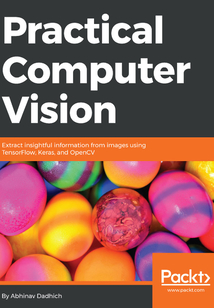舉報(bào) 

會(huì)員
Practical Computer Vision
ThisbookisformachinelearningpractitionersanddeeplearningenthusiastswhowanttounderstandandimplementvarioustasksassociatedwithComputerVisionandimageprocessinginthemostpracticalmannerpossible.SomeprogrammingexperiencewouldbebeneficialwhileknowingPythonwouldbeanaddedbonus.
目錄(201章)
倒序
- coverpage
- Title Page
- Dedication
- Packt Upsell
- Why subscribe?
- PacktPub.com
- Contributors
- About the author
- About the reviewer
- Packt is searching for authors like you
- Preface
- Who this book is for
- What this book covers
- To get the most out of this book
- Download the example code files
- Download the color images
- Conventions used
- Get in touch
- Reviews
- A Fast Introduction to Computer Vision
- What constitutes computer vision?
- Computer vision is everywhere
- Getting started
- Reading an image
- Image color conversions
- Computer vision research conferences
- Summary
- Libraries Development Platform and Datasets
- Libraries and installation
- Installing Anaconda
- NumPy
- Matplotlib
- SciPy
- Jupyter notebook
- Installing OpenCV
- OpenCV Anaconda installation
- OpenCV build from source
- Opencv FAQs
- TensorFlow for deep learning
- Keras for deep learning
- Datasets
- ImageNet
- MNIST
- CIFAR-10
- Pascal VOC
- MSCOCO
- TUM RGB-D dataset
- Summary
- References
- Image Filtering and Transformations in OpenCV
- Datasets and libraries required
- Image manipulation
- Introduction to filters
- Linear filters
- 2D linear filters
- Box filters
- Properties of linear filters
- Non-linear filters
- Smoothing a photo
- Histogram equalization
- Median filter
- Image gradients
- Transformation of an image
- Translation
- Rotation
- Affine transform
- Image pyramids
- Summary
- What is a Feature?
- Features use cases
- Datasets and libraries
- Why are features important?
- Harris Corner Detection
- FAST features
- ORB features
- FAST feature limitations
- BRIEF Descriptors and their limitations
- ORB features using OpenCV
- The black box feature
- Application – find your object in an image
- Applications – is it similar?
- Summary
- References
- Convolutional Neural Networks
- Datasets and libraries used
- Introduction to neural networks
- A simple neural network
- Revisiting the convolution operation
- Convolutional Neural Networks
- The convolution layer
- The activation layer
- The pooling layer
- The fully connected layer
- Batch Normalization
- Dropout
- CNN in practice
- Fashion-MNIST classifier training code
- Analysis of CNNs
- Popular CNN architectures
- VGGNet
- Inception models
- ResNet model
- Transfer learning
- Summary
- Feature-Based Object Detection
- Introduction to object detection
- Challenges in object detection
- Dataset and libraries used
- Methods for object detection
- Deep learning-based object detection
- Two-stage detectors
- Demo – Faster R-CNN with ResNet-101
- One-stage detectors
- Demo
- Summary
- References
- Segmentation and Tracking
- Datasets and libraries
- Segmentation
- Challenges in segmentation
- CNNs for segmentation
- Implementation of FCN
- Tracking
- Challenges in tracking
- Methods for object tracking
- MOSSE tracker
- Deep SORT
- Summary
- References
- 3D Computer Vision
- Dataset and libraries
- Applications
- Image formation
- Aligning images
- Visual odometry
- Visual SLAM
- Summary
- References
- Mathematics for Computer Vision
- Datasets and libraries
- Linear algebra
- Vectors
- Addition
- Subtraction
- Vector multiplication
- Vector norm
- Orthogonality
- Matrices
- Operations on matrices
- Addition
- Subtraction
- Matrix multiplication
- Matrix properties
- Transpose
- Identity matrix
- Diagonal matrix
- Symmetric matrix
- Trace of a matrix
- Determinant
- Norm of a matrix
- Getting the inverse of a matrix
- Orthogonality
- Computing eigen values and eigen vectors
- Hessian matrix
- Singular Value Decomposition
- Introduction to probability theory
- What are random variables?
- Expectation
- Variance
- Probability distributions
- Bernoulli distribution
- Binomial distribution
- Poisson distribution
- Uniform distribution
- Gaussian distribution
- Joint distribution
- Marginal distribution
- Conditional distribution
- Bayes theorem
- Summary
- Machine Learning for Computer Vision
- What is machine learning?
- Kinds of machine learning techniques
- Supervised learning
- Classification
- Regression
- Unsupervised learning
- Dimensionality's curse
- A rolling-ball view of learning
- Useful tools
- Preprocessing
- Normalization
- Noise
- Postprocessing
- Evaluation
- Precision
- Recall
- F-measure
- Summary
- Other Books You May Enjoy
- Leave a review - let other readers know what you think 更新時(shí)間:2021-06-30 18:55:38
推薦閱讀
- 電氣自動(dòng)化專業(yè)英語(第3版)
- 火格局的時(shí)空變異及其在電網(wǎng)防火中的應(yīng)用
- 協(xié)作機(jī)器人技術(shù)及應(yīng)用
- 樂高創(chuàng)意機(jī)器人教程(中級(jí) 下冊(cè) 10~16歲) (青少年iCAN+創(chuàng)新創(chuàng)意實(shí)踐指導(dǎo)叢書)
- 21天學(xué)通Visual Basic
- 傳感器與物聯(lián)網(wǎng)技術(shù)
- 嵌入式GUI開發(fā)設(shè)計(jì)
- Hands-On Dashboard Development with QlikView
- MPC5554/5553微處理器揭秘
- MongoDB 4 Quick Start Guide
- 大數(shù)據(jù)時(shí)代的調(diào)查師
- EDA技術(shù)及其創(chuàng)新實(shí)踐(Verilog HDL版)
- 工廠電氣控制設(shè)備
- AVR單片機(jī)C語言程序設(shè)計(jì)實(shí)例精粹
- Hands-On Data Analysis with NumPy and pandas
- 人工智能基礎(chǔ)教程:Python篇(青少版)
- iLike職場(chǎng)大學(xué)生就業(yè)指導(dǎo):C和C++方向
- Learning VMware App Volumes
- Mastering Adobe Premiere Pro CS6 Hotshot
- 數(shù)字媒體交互設(shè)計(jì)原理與方法
- 工業(yè)機(jī)器人測(cè)試與評(píng)價(jià)技術(shù)
- 光固化3D打印技術(shù)
- Java ME嵌入式程序設(shè)計(jì)
- Mastering PostGIS
- 伺服驅(qū)動(dòng)器維修手冊(cè)
- 撥開CCNA迷霧
- UGNX 5三維造型
- 可重入生產(chǎn)系統(tǒng)的多尺度建模與控制策略研究
- 數(shù)據(jù)庫應(yīng)用基礎(chǔ)(Access 2003)
- SolarWinds Orion Network Performance Monitor

